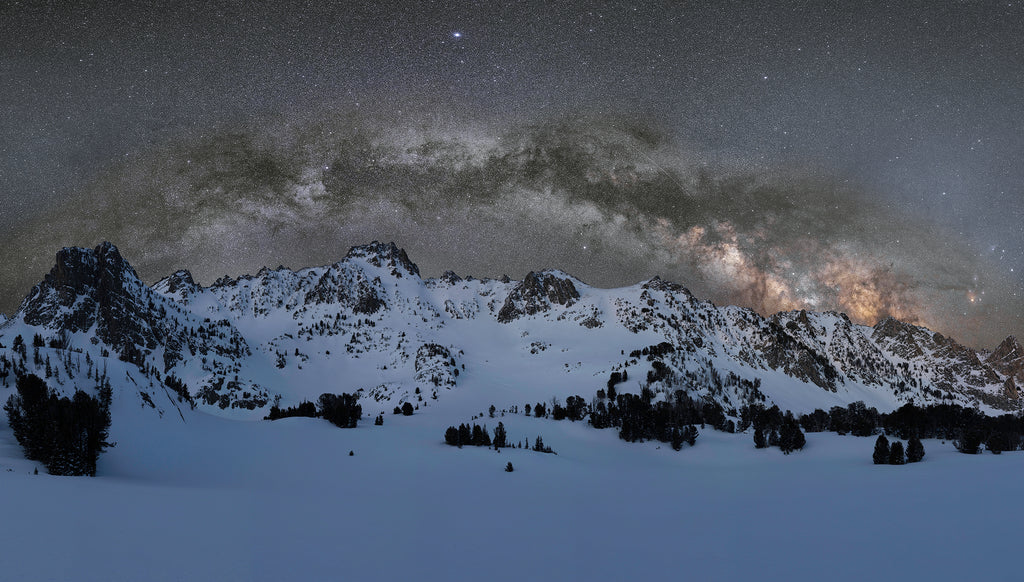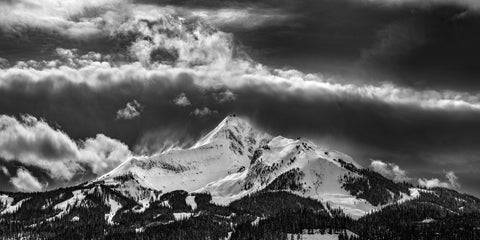August seems like more than a long time ago tonight. It hangs deep in my mind, next to childhood memories of summer that resonate with more emotion than detail – feelings that during those extended evenings when chimney swifts and nighthawks carved erratic flight paths through the sky and the Earth radiated warmth below there was unending hope. A sense of carefree joy and ease of life not yet tainted by fall’s first frost or the acrid scent of industrial cleaners used to prep a graded school’s carpet.
I take a step, supported for a moment by my snowshoe, then drop a foot into deep powder. I was here less than eight months ago but today, inching my way across this snowscape so tightly gripped by winter, I wonder if the wildflowers I remember seeing blossomed in some pleasant dream. I have been following the tracks from a pair of backcountry skiers, but they veer off toward a corniced ridge above me, leaving only this unbroken expanse of snow ahead where it’s easy to imagine that the land I traverse looks precisely as it did five thousand years ago.
I pause to catch my breath where a ragged stand of wind-battered white bark pine cluster across my path, linking slender arms and bowing toward the east like parishioners kneeling before the omnipotent gods of weather. I thrust one of my trekking poles down through the snow, searching for the frozen ground below to support myself on, but it plunges easily to its handle without resistance. I’ve got almost sixty pounds of camping and photography gear in my pack and can feel every ounce of it in my quads as my legs splay apart in a snowshoe stance I’m not accustomed to or comfortable with. As late afternoon becomes early evening, the mountains on the northern horizon, below whose peaks I’ll spend the night, don’t seem any closer than they did half an hour ago. It’s a tough way to get a picture I think as I lean into the slope and plow ahead.
It may be difficult photography, but this certainly constitutes social distancing. It’s been less than a century and a half since the first human beings laid eyes on this basin during winter. For ten thousand years before that, while nomadic hunters ventured into these mountains at the height of summer to hunt big horn sheep, no one came during the season of snow. And with good reason. I haven’t seen so much as a squirrel track, heard the throaty call of a high-soaring raven, or gotten the impression that a single living thing resides within three miles of me. I suppose that somewhere in one of these clumps of trees there’s a band of chickadees, and perhaps a pine martin has shuffled through within the past month, but if I had to subsist on what lives here, even with the world’s most modern weapons at my disposal, I’d be dead inside two weeks.
I climb fifty yards and then pause again, my lungs working hard for air. I’m approaching 10,000 feet above sea level, and I can tell there isn’t as much oxygen here. Resting, I look up at the sky where clouds blend with wispy tendrils of snow blown from deep drifts, wraiths dancing into the heavens to celebrate the coming of night. The forecast calls for clear skies, but here in the mountains that’s always a coin toss. Right now, I’ll settle for the wind dying down. It whips along from behind me, turning the hood of my sweatshirt, damp with breath and sweat, to concrete.
Onward and upward. The theme of my time in the Rocky Mountains, though my pace isn’t what it was 20 years ago. A step at a time I tell myself, marking progress by passing a dead tree, a patch of blueish, sculpted snow in a miniature bowl, and a hulking boulder whose south-facing side stands bare, the only sign that eventually spring may find this land. It will I know, as surely as these mountain clouds begin turning pink and my shadow grows, but it’s difficult to fully understand that it will occur in this lifetime, a mere couple of months from now.
Twilight. The pink glow above imparts similar color to the snow below, and for a few brief moments the world stands in pastel hues of salmon and blue. And then, in what is the best proof yet that winter is not interminable, I find that I’m at my camping site, tall peaks protecting me on three sides, dim memories of a summer pond here as abstract as the notion that all land may once have been buried beneath a globe-encircling sea.
I use a small, plastic shovel to clear away the snow inside the tree well of a massive white bark pine, digging down a few feet to the bare ground where the husks of squirrel-emptied cones lie deep over frozen earth. My tent is roughly the same shape – and size – of a giant silk moth’s cocoon, and by the time I get it set up and inflate my narrow bed pad my hands are growing numb. I tear open packet after packet of handwarmers, shaking heat into them, dropping a pair into a small bag that holds my camera, cramming the rest into my sleeping bag, which I crawl into wearing a heavy coat and insulated pants. I set the alarm on my phone for 2:50am, choke down a cold protein bar, drink a few ounces of water, and close my eyes.
Silence. It’s the most pervasive trait of winter wilderness, more so even than cold, though it is certainly that here, too. I watch my breath ascend toward the small vent in my tent’s ceiling, rising like the fingers of wind-blown snow I saw earlier. I close my eyes, imagining the paintbrush and asters that I saw the last time I was here, following the flight of a checkerspot butterfly as it tries to decide which blossom to land on next, staring after it until it is a dark speck in an ocean of color.
My alarm’s chime a few hours later signals that it’s time to do what I least feel like: relinquish my small warmth for the chill of the night. I sit up slowly, pulling my sleeping bag around me, fumbling through my pack for my Jet Boil stove that will, in under two minutes, boil the water I’m going to make instant coffee with. I hear the hiss of gas, the pop of the ignitor, and feel the warmth of flame. When my headlamp shows bubbles churning in the water, I drop in a handful of coffee, its aroma taking me back to my grandparents’ house when I was a boy and would get up early to talk with my grandfather before the rest of our family rose. I sip it slowly, cooled with a pinch of snow, feeling its heat course through my body, lending sufficient ambition to fight into my boots and crawl outside.
At high elevation on a clear night, there are so many stars visible that the sky has three-dimensional depth. It’s dizzying to look at sometimes, a thick, pile carpet pulsing and shimmering, vibrating with light billions of years old. I fumble with my snowshoes, their plastic straps protesting against manipulation, ratchet them onto my boots, and, after slinging my pack onto my shoulders, trudge thirty yards into an opening which, in July, will be open water. Again I use my shovel, digging down this time to ice as dark as the deepest folds of the sky, where I set the legs of my tripod. I attach my camera to my equatorial mount, align it with Polaris, begin its tracking rotation - its imperceptible movement following the rise of the sky - and start taking three-minute, portrait-oriented exposures. Facing east, I work north to south, overlapping the images by nearly 50%, watching the core of our Milky Way galaxy pull itself up from behind a horizon of rocky peaks. An hour passes quickly, and before any hint of dawn shows, I retake the same series of images, this time with my motorized equatorial mount turned off, allowing my camera to focus sharply on everything in the foreground. During editing, I’ll blend the two sets of photos together, the first with a sharp sky and slightly-blurred foreground, the second with acuity reversed.
By the time my shutter opens for the final time, my feet are cold and my hands have been begun to shake. I disassemble my mount, packing it and my camera securely inside my pack, work my tripod’s legs back into their contracted positions, and plow back to my tent where I make a second cup of coffee, its warmth at least as welcome as the first.
I consider packing my tent and beginning the trek out now, still more than an hour before the sun will rise, but my sleeping bag is more inviting. I unzip it, drape it over me like a silky shawl, and look up at the sliver of sky I can see through the tent's vent. It’s ironic I think that the closest things down here to what I see up there are buried deep beneath me. Down below the pine cones, under Montana’s thin layer of soil, further inside than the obsidian shards left by hunters thousands of years ago, deep down below the roots of these tall mountains where the genetic material of this planet bubbles much as it did a few billion years ago. It seems that there must be some cosmic connection between the stars and the inner Earth, between the near and the very distant, between all seasons at all times. I’m thinking about it as the checkerspot comes into view over a patch of showy asters.
“Where did you come from?” I hear myself say out loud, smiling as I drift into sleep at the realization that I can no more control my voice than I can my wonder.
** You can see the photograph I took, Winter's Glow, here, and also its summer counterpart, taken from the same place in August, Celestial Rainbow.




jack crowley
Jake- your dad’s son! Wonderful evocation of Vermont in Big Sky Country…all best, Jack Crowley Bellevue, WA and D ’56
Phillis
From Bonnie Lorimer: Thank,you Jake, for sharing what I cannot see in person. It lifts my spirits
Phillis
Your pictures are matched only by the beauty of your words. Thank you for taking us with you.
Aunt Janice
You are our voices.
Patty
Breathtaking picture.